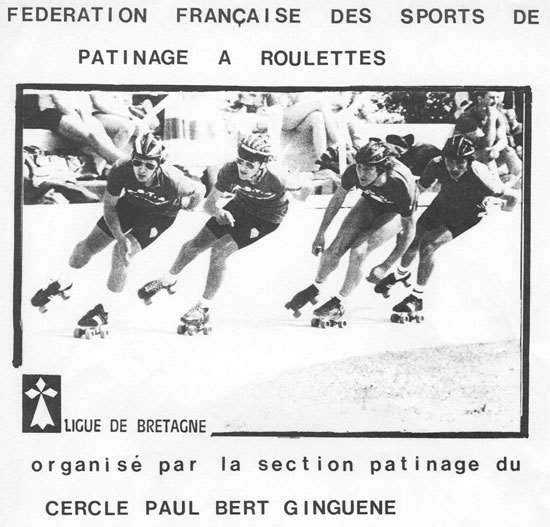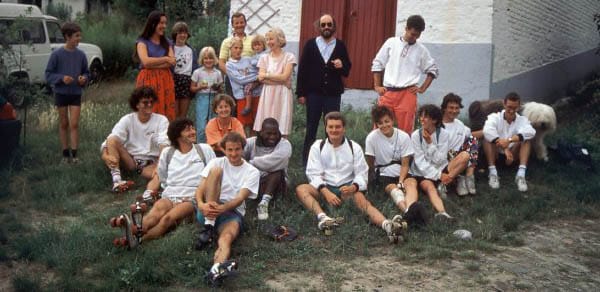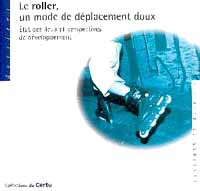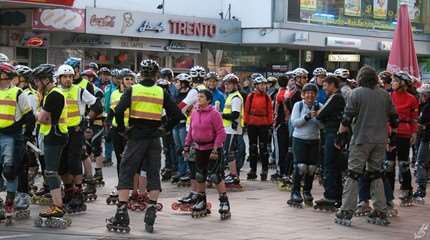Outdoors skating from the 80’s ’til today (2/2)
After our first part dedicated to the genesis of outdoors and long distance skating, let's turn the spotlight onto more recent history, onto a renewal period for outdoors skating, from 1980 'til today. Here we go for a little time warp...
Par alfathor
The revolution of urethane wheels
 The end of the 70’s and the beginning of the 80’s mark the arrival of urethane wheels. The legend says that the collapsing of the skateboarding market would have restarted that of rollerskating. The manufacturers having overstocks of wheels would have sold their merchandise in equipping traditional quad skates, giving a fresh boost to the practice. Thus the two practices would be unintendedly interconnected!
The end of the 70’s and the beginning of the 80’s mark the arrival of urethane wheels. The legend says that the collapsing of the skateboarding market would have restarted that of rollerskating. The manufacturers having overstocks of wheels would have sold their merchandise in equipping traditional quad skates, giving a fresh boost to the practice. Thus the two practices would be unintendedly interconnected!
The urethane is a polymere, a plastic material, and its flexibility offers a better grip and a greater gliding comfort to the skater. The maintenance is far easier. Skaters abandon wooden wheels with rapid wear and metal wheels with uncertain grip. New horizons on sight.
Skating events are back
Informal street skates are organized in Paris. The first editions of skating races see the light, cf. The premices of Rennes sur Roulettes at Villejean in 1982/1983.
Long distance treks: the crazy story of Ted James
Long distance skates germinate in the heads of skaters.
The most striking is certainly the travel of American Theodore James Coombs (as if by coincidence a computer engineer, there are so many in the world of skating that it is getting suspicious!)
In May 1979 he throws himself into a trek across the USA to protest against the energy crisis and the lack of fuel. He learns that Clinton Shaw has already crossed the USA and the Canada, getting several World Records doing so. He starts his journey across the USA at the gas station of Hollywood. His friend Brian Douglas follows him with his van. During his course, he breaks the record of distance in one day with 120 miles (193 k) from Breckenridge to Dallas, Texas. He is also the first skater to have crossed the Lincoln Tunnel in New York, escorted by policemen!
 On September 13th, 1979 he breaks the world record of distance in the small town of Mount Sterling, Missouri. Despite the theft of the van that followed him, he doesn’t give up and raises funds to keep on with his journey. He finally stops at Yates Center, Texas, after having travelled 5,193 miles (8,375,33 km).
On September 13th, 1979 he breaks the world record of distance in the small town of Mount Sterling, Missouri. Despite the theft of the van that followed him, he doesn’t give up and raises funds to keep on with his journey. He finally stops at Yates Center, Texas, after having travelled 5,193 miles (8,375,33 km).
Women are not outdone: Jackie Jacobs – The deputy shot the records
On December 7th, 1980 San Diego deputy sheriff Jackie Jacobs, aged 22, starts from Palm Springs, California for an attempt at record on 24 hours. She wants to skate 200 miles to enter the Guiness book of records for the second time in a row. She already has to her credit the record of the fastest continent crossing in 37 days between San Diego and Tuybee Beach.
In France, Mad Skaters stride across the country…
In France the Esplanade of Montparnasse is crowded with skaters. All the skating disciplines are mixed. The group of the Randonneurs Fous (Mad Skaters) skate there. It is not an association but it structures the practice in organizing city skates open to all, on 15 to 40 km. Then the small group throws itself into long distance travels from Paris to Deauville with Marc Petit, from Paris to Bordeaux, from Paris to Nice (1,000 km in 12 days), from Paris to Biarritz (900 km in 11 days), from Paris to Grenoble (600 km in 5 days).
At the same time, skating joins popular multidisciplinary events such as the Traversée de l’Essonne, Les Parcours du Coeur, La Grande Fête de la Forme…
Russian Roulettes
 During the summer of 1989, Pierre Surun and a group of friends decide to set off on an adventure. Originating from Rennes, they naturally decide to skate towards the East, destination Moscow, 3.000 km away. The group of the Roulettes Russes links Brittany to Moscow. Their adventure is condensed in a souvenir book. For more information, you can read the interview of the author, Pierre Surun, on OLS…
During the summer of 1989, Pierre Surun and a group of friends decide to set off on an adventure. Originating from Rennes, they naturally decide to skate towards the East, destination Moscow, 3.000 km away. The group of the Roulettes Russes links Brittany to Moscow. Their adventure is condensed in a souvenir book. For more information, you can read the interview of the author, Pierre Surun, on OLS…
Many other skating treks will be implemented across France and Europe.
In August 1994, Pierre Labaune and Guillaume Hueber, two young skaters of 20, skate from Lille to Marseille: 1,200 km of troubles, joys, encounters and mishaps.
In 1996 Fabrice Gropaiz, 26, starts a 6-month journey of 6,000 km across the USA after having tested himself with a Paris-Barcelona trip. He will also skate across Eastern Europe, Asia and even Africa!
The history of treks is very rich, we will soon dedicate a more complete article on the subject…
The 1990’s: the birth of big popular city skates
 The Randonneurs Fous would be at the origin of the big Parisian city skate at the beginning of the 90’s. In September 1993, the Rollermania association launches that meeting with a lot of members of the Randonneurs Fous.
The Randonneurs Fous would be at the origin of the big Parisian city skate at the beginning of the 90’s. In September 1993, the Rollermania association launches that meeting with a lot of members of the Randonneurs Fous.
In 1994, the start is at Place d’Italie. Initially the aim is to train people for urban skating. A hundredth of skaters take part in that weekly meeting which soon becomes unmanageable.
In 1995, at the occasion of the big strikes, the meetings become suicide city skates with a constantly growing mass of skaters. Negociations with the authorities start.
The Friday Night Fever is born in late 1997 and gets structured with the Pari Roller association which sees the light in February 1998, on request of the prefecture. The event will then reach incredible figures with nearly 20,000 participants, the Golden Age!
 At the same time, Olivier Husson and Emmanuel Jackson launch the Rollers et Coquillages city skate (which isn’t named as such yet), at first in an informal way in 1996, then more structured on December 9th, 1997.
At the same time, Olivier Husson and Emmanuel Jackson launch the Rollers et Coquillages city skate (which isn’t named as such yet), at first in an informal way in 1996, then more structured on December 9th, 1997.
The Rollers et Coquillages association also gathers dozens of thousands of skaters every Sunday afternoon at the start in Bastille. It is a relaxed skate in which you take part to chill out on skates with your friends, kids, familly, to meet people…
The Friday Night Fever creates newborns
The Friday Night Fever is part of the first big popular city skates that saw the light in France. Many other city skates were born in the capital before spreading to provinces. In Paris there are one or several skates per day, and there are skates for each type of skater: downhill enthusiasts, speed fans, culture lovers.
With a few years interval, city skates are getting structured in provinces. Let’s mention the skate of Lille (Ride On Lille), which encounters difficulties with the authorities before finding its place in the urban landscape of Lille. The big cities follow in Lille’s footsteps: Lyon (Générations Roller), Bordeaux (AIR), Marseille, Toulouse (Roulez Rose)… In France, there more than 80 regular popular city skates at the beginning of the 2000’s.
The status of skating
 The 2000’s saw the first attempts at recognition of skating and its integration into the road rules, with the publication of the much talked about Livre Blanc of the CERTU in 2001. Since then, skating has unfortunately not managed to find its place as a soft means of transport despite the considerable work made by the Commission Randonnée (Outdoors Skating Commission) of the French Federation of Roller Sports (FFRS).
The 2000’s saw the first attempts at recognition of skating and its integration into the road rules, with the publication of the much talked about Livre Blanc of the CERTU in 2001. Since then, skating has unfortunately not managed to find its place as a soft means of transport despite the considerable work made by the Commission Randonnée (Outdoors Skating Commission) of the French Federation of Roller Sports (FFRS).
The causes of the running out of steam of popular city skates
Lots of popular city skates have run out of steam since then for several reasons:
The first reason often comes from the difficulty to cooperate with the local autorities. The prefectures and local councils have long frowned upon those meetings. The lack of awareness on skating has often led the authorities to get all the skating disciplines mixed up and take drastic measures.
Followed power struggles in several big cities where the local councils couldn’t do much to contain the movement, facing hundredths of skaters invading the roads.
The second reason is the difficulty of the skating associations to maintain a motivated staff on the long term and at all seasons. Financial means are also needed to pay for the required equipment in order to ensure smooth proceedings. Subventions and means given by the local councils hâve been vectors of development or extinction of many city skates. In times of crisis, sports and culture subventions are the first ones to drop.
 A less glorious third reason of the decline of some city skates would have been the dispersal of the local figures. Many clubs didn’t manage to get along to make their meetings durable. The division between the clubs of a same city scattered the skaters and reduced the capacities of negociation with the authorities, and consequently sank several popular city skates.
A less glorious third reason of the decline of some city skates would have been the dispersal of the local figures. Many clubs didn’t manage to get along to make their meetings durable. The division between the clubs of a same city scattered the skaters and reduced the capacities of negociation with the authorities, and consequently sank several popular city skates.
Another possible cause of the drop of attendance to popular city skates may be the improvement of the technical level of the skaters. Lots of them took part in city skates to start with, and once a good technical level acquired, many skaters have favored independent skates with small groups of friends on cycle lanes.
Let’s also mention the lack of renewal in the city skate offers. The level of the skaters improving, it is important to offer varied tours, with different speeds, thematic skates to avoid the weariness and the desertion of the practice.
Last but not least let’s be realistic, the trend of the years 1995 to 2000 has deflated. On the one hand with the arrival of new practices, and on the other hand because of the lack of investment from the big brands into communication and stimulation of the market. No doubt that there will be a new boost, but for now, the machine seems to be at a standstill.
Links
Genesis of outdoors rollerskating (1/2)
The growth of long distance treks
“Rollermania”, a book of Sam Nieswizski
Officiel web site of Ted Coombs
Translation: Chloé Seyres
Photos : Rennes sur Roulettes, Pierre Surun
Sarrebruck street skating, Rollers et Coquillages
All rights reserved
